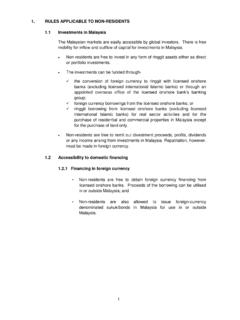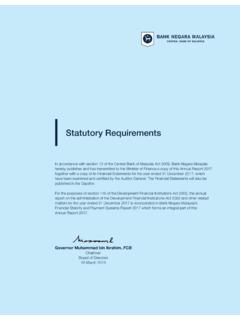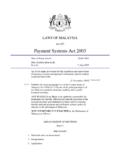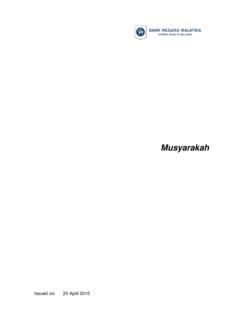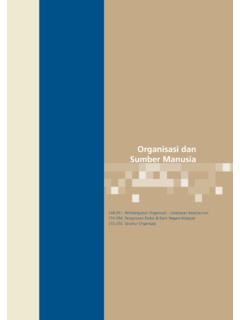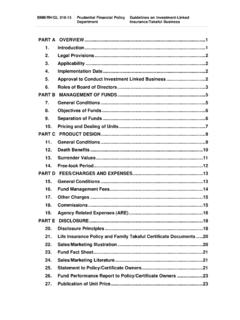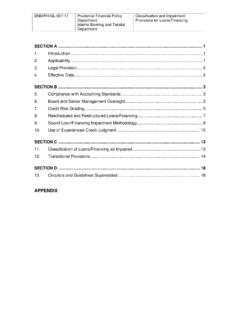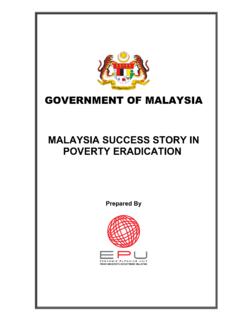Transcription of Climate Change and Principle-based Taxonomy - BNM
1 Issued on: 30 April 2021 Climate Change and Principle-based Taxonomy Applicable to: 1. Licensed banks 2. Licensed investment banks 3. Licensed international Islamic banks 4. Licensed Islamic banks 5. Licensed insurers 6. Licensed reinsurers 7. Licensed takaful operators 8. Licensed retakaful operators 9. Prescribed development financial institutions Climate Change and Principle-based Taxonomy 1 of 47 Issued on: 30 April 2021 TABLE OF CONTENTS Preface & Acknowledgement 2 Abbreviations 3 Part A: Overview Introduction 4 5 Applicability 6 Effective date 6 Related documents 6 Part B: Climate Change impact and opportunities Dimensions and transmission channels of Climate -related risks 7 9 Advancing Climate ambitions and opportunities 9 11 Part C: Assessment of Economic Activities Guiding principles for the assessment of economic activities 12 Guiding Principle 1.
2 Climate Change mitigation 12 14 Guiding Principle 2: Climate Change adaptation 14 16 Guiding Principle 3: No significant harm to the environment 16 17 Guiding Principle 4: Remedial measures to transition 18 20 Guiding Principle 5: Prohibited activities 20 21 External certification and verification 21 22 Part D: Classification of Economic Activities Classification system 23 24 Part E: Use Cases Use case 1: Financing for an expansion of oil palm plantation 25 26 Use case 2: Financing for a broiler chicken house 27 Use case 3: Refinancing a green building 28 29 Use case 4: Financing in fossil fuel-related activities 30 32 Use case 5: Investment in green assets 32 Appendices Appendix 1: Characteristics and effects of Climate Change 33 36 Appendix 2: Relevant national policies and plans to address Climate Change , biodiversity and environmental issues 37 38 Appendix 3: Examples of activities that generally meet GP1 39 41 Appendix 4: Examples of activities that generally meet GP2 42 45 Appendix 5: Examples of certification and independent verification 46 47 Climate Change and Principle-based Taxonomy 2 of 47 Issued on.
3 30 April 2021 PREFACE & ACKNOWLEDGEMENT The Climate Change and Principle-based Taxonomy (CCPT) is prepared by Bank Negara Malaysia in collaboration with the Risk Management sub-committee of the Joint Committee on Climate Change (JC3). The World Wide Fund for Nature (Malaysia and Singapore offices) also provided substantial inputs, particularly on aspects of environmental sustainability to the drafting of this document. Feedback and suggestions received during the public consultation have been incorporated in this document, where relevant. Queries and clarification may be directed to Members of Risk Management sub-committee of JC3 are listed below: 1.
4 Bank Islam Malaysia Berhad 2. Bank Pertanian Malaysia Berhad (Agrobank) 3. CIMB Bank Berhad 4. Etiqa Insurance and Takaful 5. Hong Leong Bank Berhad 6. Institutional Investors Council Malaysia 7. Malayan Banking Berhad 8. Nomura Asset Management Malaysia Sdn Bhd 9. Securities Commission Malaysia 10. Standard Chartered Bank Malaysia Berhad 11. Zurich Insurance and Takaful DISCLAIMER: The views, findings, interpretations and conclusions expressed in this document do not necessarily represent the decision or the stated policy of the Bank, nor does citing of trade names or commercial processes constitute endorsement. Climate Change and Principle-based Taxonomy 3 of 47 Issued on.
5 30 April 2021 ABBREVIATIONS AMC Asset management company CCPT Climate Change and Principle-based Taxonomy CDP Carbon Disclosure Project CO2 Carbon dioxide EIA Environmental Impact Assessment EPU Economic Planning Unit, Prime Minister s Department EQA 1974 Environmental Quality Act 1974 ESG Environmental, social and governance FIs Financial institutions GDP Gross domestic product GHG Greenhouse gas IFI International Financial Institution IPBES Intergovernmental Panel Science-Policy Platform on Biodiversity and Ecosystem Services IPCC Intergovernmental Panel on Climate Change ITOs Insurers and takaful operators JC3 Joint Committee on Climate Change LULUCF Land Use.
6 Land-Use Change and Forestry MGP Malaysian Sustainable Palm Oil General Principle MSPO Malaysian Sustainable Palm Oil NDC Nationally determined contributions RE Renewable energy TCFD Task Force on Climate -Related Financial Disclosures UNDP United Nations Development Programme UNFCCC United Nations Framework Convention on Climate Change UN PRI United Nation principles for Responsible Investment VBI Value- based Intermediation VBIAF Value- based Intermediation Financing and Investment Impact Assessment Framework WWF World Wide Fund for Nature Climate Change and Principle-based Taxonomy 4 of 47 Issued on: 30 April 2021 PART A OVERVIEW 1 Introduction Climate Change has significant impacts on the society, economy and financial system.
7 Such changes can be observed through many ways such as a rise in surface temperature and sea level, volatility in local Climate including drought and rainfall patterns, and higher frequency and severity of disaster occurrences. These changes are occurring at an unprecedented level, with human activity largely responsible1 (refer to Appendix 1 for the characteristics and effects of Climate Change ). Malaysia has experienced an increase in surface mean temperature of C to C per decade since 1969 to The impact of physical risk resulting from Climate -related events and disasters has been significant with occurrences of more than 50 natural disasters in the past 20 years.
8 These disasters have resulted in over RM8 billion monetary losses and affected the lives and livelihoods of more than 3 million people in Malaysia through displacements, injuries and Climate Change also affects biodiversity, ecosystems, and natural resources such as fresh water, air and soil nutrients. In food production for example, increases in temperature can reduce the quality and quantity of cultivated crops, and lower the resilience of agroecosystems against pests and pathogens. Environmental degradation may also reduce the capacity of the ecosystems to absorb This demonstrates the close interlinkages and interactions between Climate -related and environmental risks, with negative feedback loops that reinforces the damage from the materialisation of these risks.
9 Failure to recognise and manage Climate and environmental-related risks may therefore lead to substantial financial consequences for businesses and households, as well as FIs that provide financing or investment to those exposed to such risks. As corporate citizens and given the impact of Climate Change on enterprise value, viability and profitability, it is imperative that FIs integrate Climate Change considerations in all aspects of their business strategies and 1 IPCC. (2014). Fifth Assessment Report and IPCC (2018) Special Report: Global Warming of C.
10 2 Ministry of Environment and Water. (December 2020). Malaysia s Third Biennial Update Report submitted to the UNFCCC. 3 Zurairi AR. (October 2018). Climate -related natural disasters cost Malaysia RM8b in last 20 years . 4 Ecosystems such as forests, soils and oceans provide essential carbon storage as they absorb 60% of all anthropogenic carbon emissions. IPBES. (2019). The Global Assessment Report on Biodiversity and Ecosystem Services, Summary for Policymakers. Climate Change and Principle-based Taxonomy 5 of 47 Issued on: 30 April 2021 operations including human capital and compensation, risk management processes and public disclosures.

